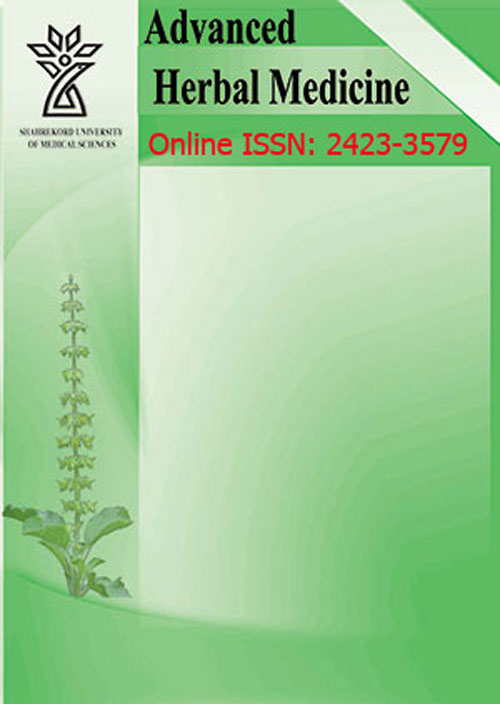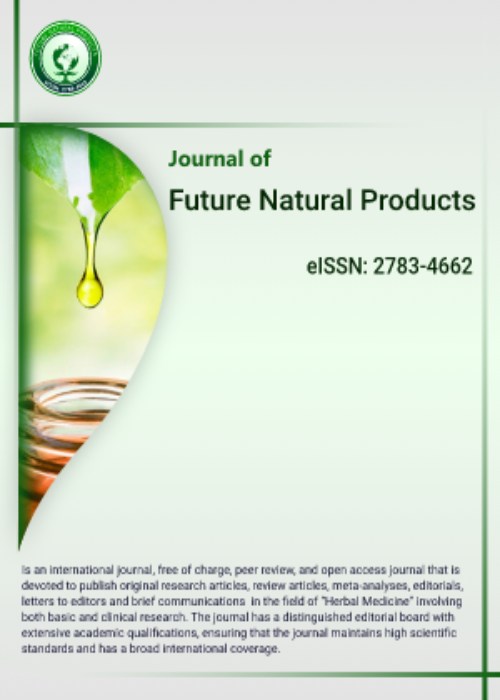فهرست مطالب

Future Natural Products
Volume:6 Issue: 1, Winter-Spring 2020
- تاریخ انتشار: 1400/04/08
- تعداد عناوین: 5
-
Pages 1-13BackgroundPolycystic ovary syndrome (PCOS) is one of the most common endocrine disorders with a spread of around 10% in the world. Yarrow (Achillea millefolium L.) is a medicinal plant with essential oils, steroids, flavonoids and phenolic compounds. The aim of this study was to investigate the effects of yarrow extract on blood hormones and ovarian histology in rat model of PCOS.MethodsSeventy rats were equally allocated into seven groups: control; control+1.2g/kg body weight (BW) yarrow extract; PCOS, induced by single-dose intramuscular injection of estradiol valerate (EV, 1 mg/100g BW); PCOS+2 mg/kg BW clomiphene citrate (CC); PCOS+1.2, 2.5 and 5g/kg BW of yarrow extract for a period of 30 days. Vaginal smear was performed for 60 days after the EV injection. Hormone assays for LH, FSH, progesterone, testosterone and estradiol, and ovarian histology were also performed.ResultsCC could moderate serum levels of FSH, estrogen and progesterone and concentrations of LH, LH/FSH and testosterone became normal, whereas CC did not have a significant effect on body and ovary weights, and number of ovarian cysts. Yarrow extract could ameliorate the body and ovary weights, cystic follicles and sex hormones in PCOS induced by EV in a dose-dependent manner. High dose of yarrow extract improved the detrimental effects of PCOS on body and ovary weights, and number of ovarian cysts, and caused them to reach normal levels.ConclusionYarrow extract in 5mg/kg BW may be used as a nutritional supplement for adjunct therapy of PCOS patients.Keywords: Achillea millefolium L, estradiol valerate, estrous cycles, ovary, sex hormone
-
Pages 14-27Background and aimHIV/AIDS drugs usually have undesirable side effect. Moringa oleifera is a plant that has been uses for various beneficial purposes. The aim of this study is to investigate the potential benefits of Moringa oleifera on blood triglyceride and low density lipoprotein (LDL) levels in patient receiving tenofovir/lamivudine/efavirenz (TLE) combination therapy.MethodsThe protocol was designed as a Longitudinal Randomized Comparative Trial (LRCT) involving 140 HIV adult subjects (56 men and 84 women) who had already been on TLE (300/300/600mg) combination therapy for at least 6 months prior to the study. They were enrolled from a teaching hospital in Nigeria. M. oleifera capsules (200mg) were given to the subjects to be used from the first day as visit 0 until visit 1 (four weeks after) and 2 (12 weeks after). Blood samples of subjects were collected at visits 0, 1 and 2 and serum analyzed for triglyceride and LDL levelsResultsThere was a significant decrease in serum LDL level (p <0.01) at visit 1 compared to visit 0. There was also significant (p <0.01) improvement compared to visit 0 and visit 1. There was a significant decrease in blood triglyceride level (p <0.01) at visit 1 compared to visit 0 of TLE combination. At visit on day 2, there was a further significant decrease in triglyceride level compared to visit 0ConclusionM. oleifera may be useful in improving blood triglyceride and LDL levels of patients receiving TLE combination.ConclusionM. oleifera may be useful in improving blood triglyceride and LDL levels of patients receiving TLE combination.Keywords: Moringa oleifera, Blood, Glucose, Tenofovir, Tenofovir, Lamivudine, efavirenz
-
Pages 28-55
Inflammatory responses are the consequences of infection, injury, and tissue dysfunctions. In general, these responses associate with the inception of several diseases such as rheumatoid arthritis, diabetes, allergy, asthma, cancer, epilepsy, and Alzheimer's disease. To enhance such responses a number of synthetic drugs are widely used, including steroidal/non-steroidal components, antibodies, and cytokine inhibitors. However, prolonged use of these components may generate some side effects, including the malfunction of digestive tract, liver intoxication, kidney damage, and cardiovascular disorders. Therefore, alternative application of natural compounds, such as herbal components, against inflammatory responses might be safer and more effective. Frankincense is a gum resin with potential therapeutic effects on various diseases with signs of inflammation. Therefore, frankincense can decrease the indications of numerous illnesses with the least side effects. The identification of critical active constituents in frankincense may be useful for the development of new components with desired biological effects. In this review, the potential therapeutic effects of frankincense will be described based on its anti-inflammatory effects.
Keywords: Alzheimer’s Disease, Anti-inflammatory, Cancer, Diabetes Mellitus, Frankincense, Rheumatoid arthritis -
Pages 56-62Background and aims
Consumption of Lactuca virosa can induce toxic outcomes. Wild lettuce occurs in many countries including Iran, and some native peoples eat leaves and stems of this plant while they are unaware of its adverse side effects. Livestock feeding with this plant causes toxicity. In this report, clinical signs and clinicopathological findings of this rare case of poisoning due to wild lettuce toxicity in a lamb were described.
Case presentationIn the autumn of 2019, a lamb was referred to the veterinary teaching hospital of the School of Veterinary Medicine, Urmia University, Iran. According to the owner's description, this female lamb consumed large amounts of Lactuca virosa. In clinical examination, nervous system alteration with depression, weakness, ataxia, dullness, somnolence, drooping of the ears, and eyelids were seen. The animal had anorexia and tachycardia. The main clinical findings in the eyes were nystagmus, mydriasis, and the absence of menace reflex with the presence of direct pupillary light reflex that indicated central blindness. To the best of our knowledge, this is the first report of Lactuca virosa-induced poisoning in lamb.
ConclusionLactuca virosa could induce toxicity in lamb that leads to mainly CNS dysfunctions. According to this experience, access restriction to toxic plant and conservative treatment including the laxative and vitamin B1 administration could be useful as the basis of treatment.
Keywords: Poisoning, Lactuca virosa, Lamb -
Pages 63-70Background and aims
Over 70% of Iranians treat their diseases by using medicinal plants and about 67% of these plants are prepared and distributed by herbal stores. Many people working in the herbal stores do not have specialized or academic education related to medicinal plants. Due to the importance of medicinal plants in human health, this study was conducted to determine the level of education and training courses of employees in herbal stores in Chaharmahal and Bakhtiari Province, Iran.
MethodsIn this descriptive study, 48 people participated and the method of sampling was convenience.The data collection tool was a questionnaire that was filled out through interviews. The collected data were analyzed using SPSS software.
Results62.5% of people did not have specialized education related to herbalism. 54.2% of the participants had attended related training courses and 45.8% had not. 70.8% of people had participated in private training courses and 29.2% had participated in university courses. The most important educational need of the participants was related to the amount of consumption, followed by side effects and interaction of medicinal plants with chemical drugs. 73.8% of people tended to attend courses offered by universities.
ConclusionHalf of the preparation and distribution of medicinal plants is done by inexperienced people with low education. This is an unprofessional behavior and illegal medical intervention that causes many problems and complications in patients. These interventions require correction. Authorized organizations should improve the scientific level of employees using educational interventions and programs and prevent the activities of unauthorized people.
Keywords: Educational Needs Assessment, education, Training Course, Herbalis


